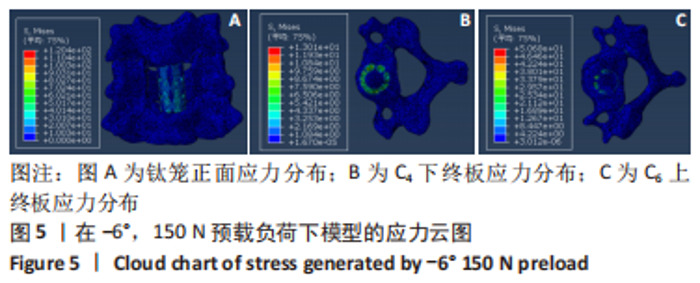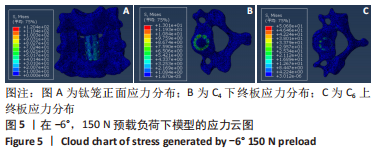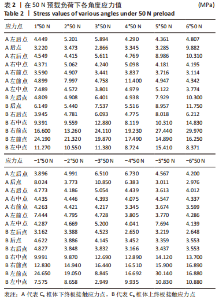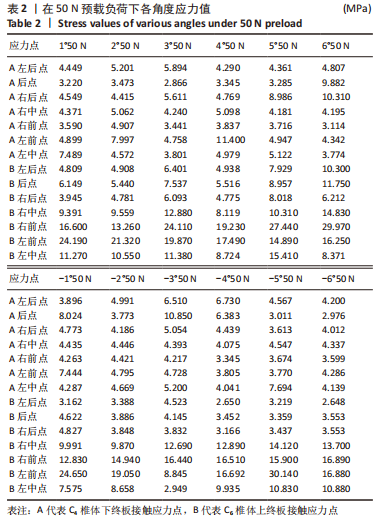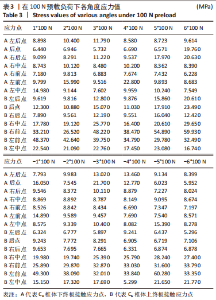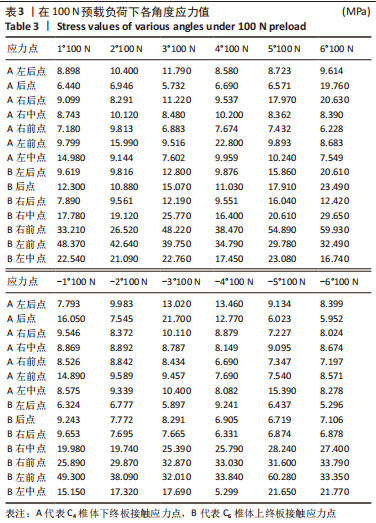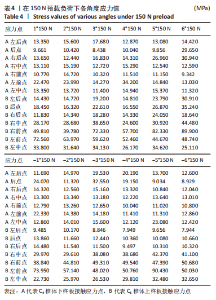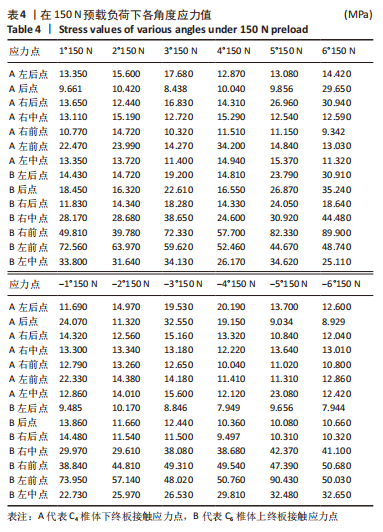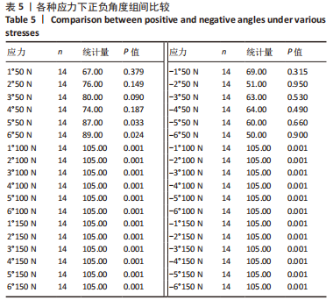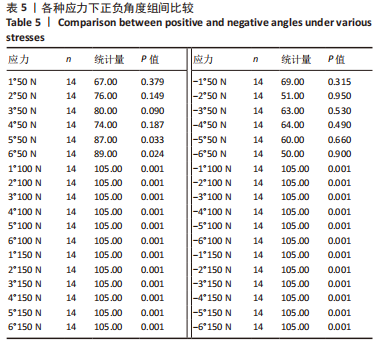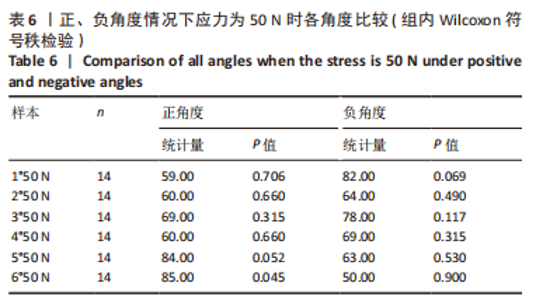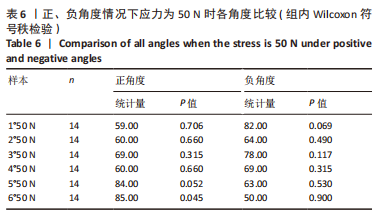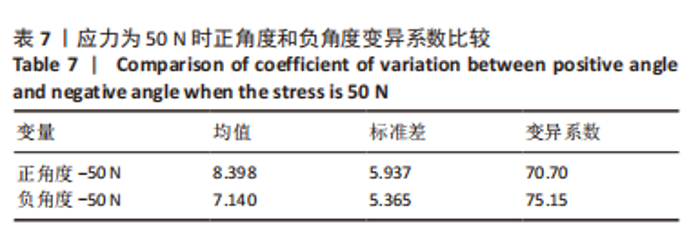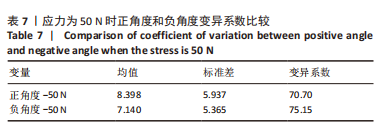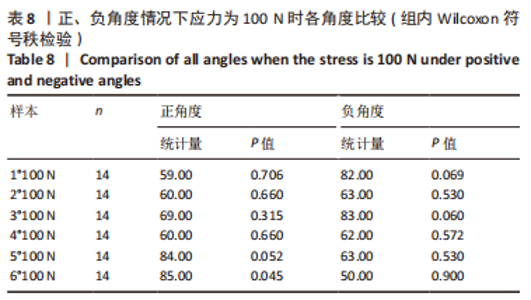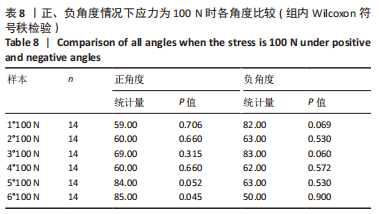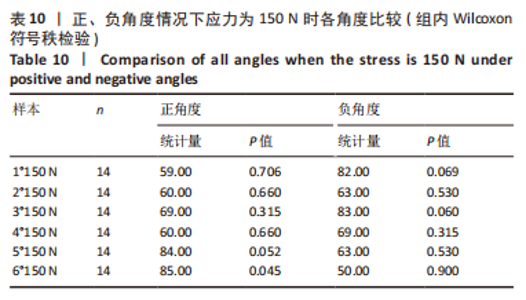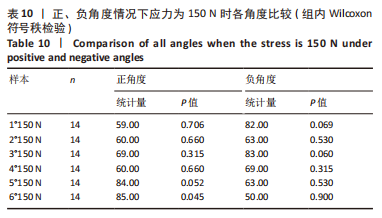Chinese Journal of Tissue Engineering Research ›› 2024, Vol. 28 ›› Issue (9): 1313-1319.doi: 10.12307/2023.919
Finite element analysis of the correlation between tilt angle of titanium cage and postoperative subsidence of titanium cage after anterior subtotal cervical corpectomy, decompression and fusion
Li Zhifei1, Yang Yin2, Chen Hualong3, Liang Qinqiu2, Zhong Yuanming1, Zhang Yisheng1
- 1First Affiliated Hospital of Guangxi University of Chinese Medicine, Nanning 530000, Guangxi Zhuang Autonomous Region, China; 2Graduate School of Guangxi University of Chinese Medicine, Nanning 530000, Guangxi Zhuang Autonomous Region, China; 3Yulin Bone Trauma Hospital, Yulin 537000, Guangxi Zhuang Autonomous Region, China
-
Received:2022-10-31Accepted:2023-02-08Online:2024-03-28Published:2023-07-25 -
Contact:Zhang Yisheng, Doctoral candidate, Attending physician, First Affiliated Hospital of Guangxi University of Chinese Medicine, Nanning 530000, Guangxi Zhuang Autonomous Region, China -
About author:Li Zhifei, Master, Chief physician, First Affiliated Hospital of Guangxi University of Chinese Medicine, Nanning 530000, Guangxi Zhuang Autonomous Region, China Zhang Yisheng, Doctoral candidate, Attending physician, First Affiliated Hospital of Guangxi University of Chinese Medicine, Nanning 530000, Guangxi Zhuang Autonomous Region, China -
Supported by:the National Natural Science Foundation of China, No. 82260942 (to ZYM); Guangxi Key Research & Development Plan, No. AB20159018 (to ZYM); Guangxi First-Class Discipline Project, No. [2018]12 (to ZYM)
CLC Number:
Cite this article
Li Zhifei, Yang Yin, Chen Hualong, Liang Qinqiu, Zhong Yuanming, Zhang Yisheng. Finite element analysis of the correlation between tilt angle of titanium cage and postoperative subsidence of titanium cage after anterior subtotal cervical corpectomy, decompression and fusion[J]. Chinese Journal of Tissue Engineering Research, 2024, 28(9): 1313-1319.
share this article
Add to citation manager EndNote|Reference Manager|ProCite|BibTeX|RefWorks

2.4 统计学结果分析 2.4.1 正负角度组间比较分析 结合正负角度两组数据分别在50,100和150 N时 Mann-Whitn检验结果发现,差异均有显著性意义(P < 0.05)。综合其两组数据的离散系数,离散系数越小,其各点间的应力差别越小,就越有利于钛笼的稳定。正角度组在3种应力条件下,离散系数均小于负角度组,前者的各点间应力差别小,在生物力学上更趋于稳定。也就是表明正角度组形成的前长后短的钛笼形状比负角度组形成的前短后长的钛笼形状更加稳定。 2.4.2 在3种应力条件下正角度组组内比较分析 在3种应力条件下,正角度组内Wilcoxon 符号秩检验发现1°-5°差异无显著性意义(P > 0.05);6°时差异有显著性意义(P < 0.05)。表明在1°-5°区间内各点应力差别不大,更趋于稳定。而6°时各点应力与前者度数相比有着明显差别,开始变得不稳定。因此,钛笼倾斜角在1°-5°区间内形成前长后短的钛笼形状更加稳定,不易下沉。 2.4.3 在3种应力条件下负角度组组内比较分析 在3种应力条件下,正角度组内Wilcoxon 符号秩检验发现-1°至-6°,差异无显著性意义(P > 0.05)。结合其离散系数均大于正角度组的离散系数,表现各应力点之间应力值差别大。因此,负角度组钛笼倾斜角在-1°至-6°区间内形成的前长后短的钛笼形状不稳定,容易下沉。"

| [1] BAILEY RW, BADGLEY CE. Stabilization of the cervical spine by anterior fusion. J Bone Joint Surg Am. 1960;42-A:565-594. [2] 何达,赵经纬,田伟.下颈椎前路间盘切除融合术与椎体次全切除融合术[J].骨科临床与研究杂志,2018,3(1):52-56. [3] 钟远鸣,莫日养,梁梓扬,等.脊髓型颈椎病的手术治疗研究进展[J].中国全科医学,2018,25(8):998-1002. [4] HARTMANN S, TSCHUQQ A, OBERNAUER J, et al. Cervical corpectomies:results of a survey and review of the literature on diagnosis, indications, and surgical technique. Acta Neurochir (Wien). 2016;158(10):1859-1867. [5] 马燕燕,桑裴铭,陈斌辉,等.脊髓型颈椎病颈前路椎体次全切钛网植骨融合内固定术后食管肿胀变化的影像学研究[J].中国骨与关节损伤杂志,2021,36(5):479-481. [6] MIAO DC, ZHANG BY, LEI T, et al. Clinical efficacy of anterior partial corpectomy and titanium mesh fusion and internal fixation for treatment of old fracture dislocation of the lower cervical spine. Med Sci Monit. 2017;23:5675-5682. [7] DORIA C, MOSELE GR, BALSANO M, et al. Anterior decompression and plate fixation in treatment of cervical myelopathy:A multicentric retrospective review. Acta Orthop Traumatol Turc. 2018;52(3):185-190. [8] YANG HS, KIM KW, OH YM, et al. Usefulness of titanium mesh cage for posterior C1-C2 fixation in patients with atlantoaxial instability. Medicine. 2017;96(36):e8022. [9] ZHANG HQ, WANG YX, WU JH, et al. Debridement and interbody graft using titanium mesh cage, posterior monosegmental instrumentation,and fusion in the surgical treatment of monosegmental lumbar or lumbosacral pyogenic vertebral osteomyelitis via a posterior-only approach. World Neurosurg. 2020;135:e116-e125. [10] CHEN Y, CHEN D, GUO Y, et al. Subsidence of titanium mesh cage: A study based on 300 cases. Spinal Disord Tech. 2008;21(7):489-492. [11] 孙玛骥,王秋安,张星晨,等.新型颈椎前路经椎弓根固定钉板系统的研制及生物力学分析[J].中国组织工程研究,2021,25(24): 3821-3825. [12] BAILEY RW, BADGLEY CE. Stabilization of the cervical spine by anterior fusion. J Bone Joint Surg Am. 1960;42-A:565-594. [13] SHRIVER MF, LEWIS DJ, KSHETTRY VR, et al. Pseudoarthrosis rates in anterior cervical discectomy and fusion: A meta-analysis. Spine J. 2015;15(9):2016-2027. [14] PANJABI MM, CHEN NC, SHIN EK, et al. The cortical shell architecture of human cervical vertebral bodies.Spine. 2001;26(22):2478-2484. [15] 李光灿,李靖年,郑连杰,等.颈椎终板抗压强度分布规律的生物力学研究[J].中国矫形外科杂志,2011,19(15):1287-1290. [16] KANI KK, CHEW FS. Anterior cervical discectomy and fusion:review and update for radiologists. Skeletal Radiol. 2018;47(1):7-17. [17] YANG HS, KIM KW, OH YM, et al. Usefulness of titanium mesh cage for posterior C1-C2 fixation in patients with atlantoaxial instability.Medicine (Baltimore). 2017;96(36):e8022. [18] 唐福波,周劲衍,张翼升,等.颈椎前路单椎体次全切钛笼植骨融合后钛笼下沉的相关危险因素[J].中国组织工程研究,2019,23(12): 1818-1823. [19] 周波,贺西京. Zero-P治疗单节段脊髓型颈椎病的临床疗效分析[J].实用骨科杂志,2016,22(9):769-773. [20] PANJABI MM, CHEN NC, SHIN EK, et al. The cortical shell architecture of human cervical vertebral bodies. Spine. 2001;26(22):2478-2484. [21] 李光灿,李靖年,郑连杰,等.颈椎终板抗压强度分布规律的生物力学研究[J].中国矫形外科杂志,2011,19(15):1287-1290. [22] 徐成,张超,巨圆圆,等.一种新型颈椎前路可固定式钛笼三维有限元模型的建立[J].中国医学装备,2019,16(6):8-11. [23] 陈勤,伍耀宏,刘宁,等.颈椎前路椎体次全切除术中钛笼形态对术后颈椎矢状面形态参数的影响[J].中国医学创新,2021,18(15): 37-42. [24] 宋萌,朱灏宇,朱庆三,等.单节段颈椎椎体次全切除钛笼植骨融合术后钛笼下沉相关危险因素分析[J].中国脊柱脊髓杂志,2017, 27(8):681-685. [25] KANI KK, CHEW FS. Anterior cervical discectomy and fusion:review and update for radiologists. Skeletal Radiol. 2018;47(1):7-17. [26] YANG HS, KIM KW, OH YM, et al. Usefulness of titanium mesh cage for posterior C1-C2 fixation in patients with atlantoaxial instability. Medicine (Baltimore). 2017;96(36):e8022. |
| [1] | Ouyang Beiping, Ma Xiangyang, Luo Chunshan, Zou Xiaobao, Lu Tingsheng, Chen Qiling. Three-dimensional finite element analysis of a new horizontal screw-screw crosslink in posterior atlantoaxial internal fixation [J]. Chinese Journal of Tissue Engineering Research, 2024, 28(9): 1320-1324. |
| [2] | Chen Mengmeng, Bao Li, Chen Hao, Jia Pu, Feng Fei, Shi Guan, Tang Hai. Biomechanical characteristics of a novel interspinous distraction fusion device BacFuse for the repair of lumbar degenerative disease [J]. Chinese Journal of Tissue Engineering Research, 2024, 28(9): 1325-1329. |
| [3] | Liang Cheng, Zhang Linqi, Wang Guan, Li Wen, Duan Ke, Li Zhong, Lu Xiaobo, Zhuo Naiqiang. Finite element and biomechanical analysis of different implants in repair for unilateral unstable pelvic posterior ring injury [J]. Chinese Journal of Tissue Engineering Research, 2024, 28(9): 1336-1341. |
| [4] | Yang Junliang, Lu Tan, Xu Biao, Jiang Yaqiong, Wang Fucheng. Three-dimensional finite element analysis of effects of partial anterior cruciate ligament rupture on knee joint stress [J]. Chinese Journal of Tissue Engineering Research, 2024, 28(9): 1347-1353. |
| [5] | Weng Rui, Lin Dongxin, Guo Haiwei, Zhang Wensheng, Song Yuke, Lin Hongheng, Li Wenchao, Ye Linqiang. Abnormal types of intervertebral disc structure and related mechanical loading with biomechanical factors [J]. Chinese Journal of Tissue Engineering Research, 2024, 28(9): 1436-1442. |
| [6] | Xiaheida·Yilaerjiang, Nijiati·Tuerxun, Reyila·Kuerban, Baibujiafu·Yelisi, Chen Xin. Three-dimensional finite element analysis of the distribution pattern of stress in bone tissues with different characteristics [J]. Chinese Journal of Tissue Engineering Research, 2024, 28(8): 1277-1282. |
| [7] | Zhuang Xinyi, Peng Yuanhao, Yu Ting, Lyu Dongmei, Wen Xiujie, Cheng Qian. Cone-beam CT evaluation of bone mass in the external oblique line of the mandible in adolescents with different cervical vertebral bone ages [J]. Chinese Journal of Tissue Engineering Research, 2024, 28(8): 1253-1258. |
| [8] | Wang Qiang, Li Shiyun, Xiong Ying, Li Tiantian. Biomechanical changes of the cervical spine in internal fixation with different anterior cervical interbody fusion systems [J]. Chinese Journal of Tissue Engineering Research, 2024, 28(6): 821-826. |
| [9] | Wei Yuanbiao, Lin Zhan, Chen Yanmei, Yang Tenghui, Zhao Xiao, Chen Yangsheng, Zhou Yanhui, Yang Minchao, Huang Feiqi. Finite element analysis of effects of sagittal cervical manipulation on intervertebral disc and facet joints [J]. Chinese Journal of Tissue Engineering Research, 2024, 28(6): 827-832. |
| [10] | Zhang Rui, Wang Kun, Shen Zicong, Mao Lu, Wu Xiaotao. Effects of endoscopic foraminoplasty and laminoplasty on biomechanical properties of intervertebral disc and isthmus [J]. Chinese Journal of Tissue Engineering Research, 2024, 28(6): 833-839. |
| [11] | Kang Zhijie, Cao Zhenhua, Xu Yangyang, Zhang Yunfeng, Jin Feng, Su Baoke, Wang Lidong, Tong Ling, Liu Qinghua, Fang Yuan, Sha Lirong, Liang Liang, Li Mengmeng, Du Yifei, Lin Lin, Wang Haiyan, Li Xiaohe, Li Zhijun. Finite element model establishment and stress analysis of lumbar-sacral intervertebral disc in ankylosing spondylitis [J]. Chinese Journal of Tissue Engineering Research, 2024, 28(6): 840-846. |
| [12] | Zhang Min, Peng Jing, Zhang Qiang, Chen Dewang. Mechanical properties of L3/4 laminar decompression and intervertebral fusion in elderly osteoporosis patients analyzed by finite element method [J]. Chinese Journal of Tissue Engineering Research, 2024, 28(6): 847-851. |
| [13] | Xue Xiaofeng, Wei Yongkang, Qiao Xiaohong, Du Yuyong, Niu Jianjun, Ren Lixin, Yang Huifeng, Zhang Zhimin, Guo Yuan, Chen Weiyi. Finite element analysis of osteoporosis in proximal femur after cannulated screw fixation for femoral neck fracture [J]. Chinese Journal of Tissue Engineering Research, 2024, 28(6): 862-867. |
| [14] | Huang Peizhen, Dong Hang, Cai Qunbin, Lin Ziling, Huang Feng. Finite element analysis of anterograde and retrograde intramedullary nail for different areas of femoral shaft fractures [J]. Chinese Journal of Tissue Engineering Research, 2024, 28(6): 868-872. |
| [15] | Wang Mingming, Zhang Zhong, Sun Jianhua, Zhao Gang, Song Hua, Yan Huadong, Lyu Bin. Finite element analysis of three different minimally invasive fixation methods for distal tibial fractures with soft tissue injury [J]. Chinese Journal of Tissue Engineering Research, 2024, 28(6): 879-885. |
| Viewed | ||||||
|
Full text |
|
|||||
|
Abstract |
|
|||||
